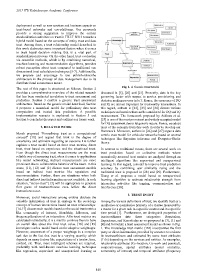Page 164 - Proceedings of the 2017 ITU Kaleidoscope
P. 164
2017 ITU Kaleidoscope Academic Conference
deployment as well as new services and business aspects on
trust-based networks and eco-platforms. Our proposals
provide a strong suggestion to improve the current
standardization activities on trust in ITU-T SG13 towards a
hybrid model based on the concepts of entity trust and data
trust. Among them, a trust relationship model described in
this work elaborates some important factors when it comes
to trust based decision making that is a vital part of
standardization process. On the other hand, trust evaluation
via ensemble methods, which is by combining numerical,
machine learning and recommendation algorithms, provides
robust perception about trust compared to traditional one
dimensional trust calculation techniques [5-7]. Additionally,
we propose and encourage to use publish-subscribe
architecture in the process of data management due to its
distributed and autonomous nature.
Fig. 1. A Generic Trust Model
The rest of this paper is structured as follows. Section 2
provides a comprehensive overview of the related research discussed in [5], [20] and [21]. Presently, data is the key
that has been conducted in relation to trust assessment and governing factor with respect to service provisioning and
prediction. Section 3 confers a generic trust assessment decision making process in IoT. Hence, the assurance of DQ
architecture. Based on the generic model described, Section and IQ are utmost important for trustworthy interactions. In
4 proposes a numerical model for preliminary data trust this regard, authors in [22], [23] and [24] discuss various
computation and trusted data prediction. A possible techniques and metrics that can be considered for DQ and IQ
implementation scenario is explained in Section 5 and measurement. The framework proposed by Askham et al.
Section 6 concludes the paper and outlines our future work. [25] is one of the most prominent and widely accepted model
for DQ assessment due to its generic nature. Hence, we adopt
2. RELATED WORK most of the concepts from this work in order to develop our
framework. Moreover, authors in [26] and [27] argue a data
Marsh proposed "Formalizing trust as a computational centric trust model for vehicular networks based on several
concept” [10] and argued that trust is the degree of techniques like Bayesian inference and Dempster-Shafer
uncertainty and optimism regarding an outcome. He further theory.
explains a trust model based on three trust metrics, direct
trust, trust based on experience and the situational trust. In contrast to traditional means, there are several work on
Even though the direct trust measurements are the most trust prediction based on collective methods where
reliable way of assessing trust, when it comes to applications numerically assessed trust metrics are analyzed through an
like social networking, indirect measurements are more intelligent algorithms like supervised and unsupervised
prominent due to collaborative behavior of the users. In this learning. In this regard, a model to improve trust prediction
sense, [11], [12] and [2] discuss trust assessment models accuracy by combining user similarity rating and the
based on indirect trust metrics like reputation and traditional trust is proposed in [28] and [29]. Furthermore,
recommendation. Further, there are situations when both Xiang et al. proposes a model based on unsupervised
direct and indirect trust information are not available. In such learning algorithm to estimate relationship strength from
situation, “stereo-trust” [13] will be appropriate to generate interaction activities like tagging, communication and
first guess of trustworthiness even before the direct interference [30].
interactions occur.
3. TRUST IN IOT
Moreover, social interactions among entities disclose the
valuable information of trust in analogy to the sociology Among the various definitions of trust, we identify trust as a
concept of human interactions based on trust relationships. qualitative or quantitative property of a trustee measured by
[14-17] discuss such models based on the social trust metrics a trustor for a given task in a specific context and in a specific
like community of interest, friendship, followers, and time period [1]. Furthermore, we distinguish properties of
frequency/duration of an interaction. After trust metrics are trustworthiness into three categories: Reputation,
calculated individually, it is a must to combine them to have Experience, and Knowledge as we proposed in [3], [1] and
an overall idea about the final trust value. [18] and [19] [4] and formulate a trust assessment model as shown in Fig.
investigate such a model based on the adaptive weightages. 1. The Knowledge trust metric (TM) incorporates the first
However, assessment of a proper weightage is a complex party or direct information, provided by a trustee to evaluate
task due to the fact that trust is a varying quantity which its trustworthiness and estimated by some trust attributes
depends on many factors like expectations of a trustor, time, (TAs) depending on the services and entities. As examples,
context, etc. Thus, more intelligent schemes are required, relationship attributes (Co-location, Co-work and parental),
preferably with well-known machine learning techniques cooperativeness, spatial attributes (social centrality,
like regression, supervised and unsupervised learning as community of interest) and temporal attributes (frequency
– 148 –

